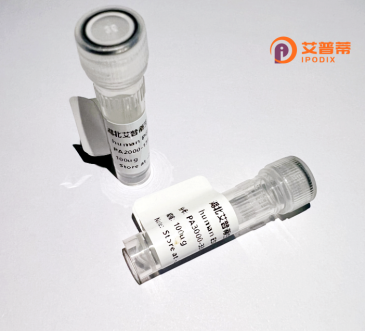
| 纯度 | >90%SDS-PAGE. |
| 种属 | Human |
| 靶点 | GLT1D1 |
| Uniprot No | Q96MS3 |
| 内毒素 | < 0.01EU/μg |
| 表达宿主 | E.coli |
| 表达区间 | 1-266aa |
| 氨基酸序列 | MRLLFLAVLRPHTGNAVTAQRVRAHLEAAGHVCVLKDAFDFESRSEIANLILAENCEAALALHLYRGGRLLQGHRIPFGVIFGGTDVNEDANQAEKNTVMGRVLEEARFAVAFTESMKEMAQAQWVDPVFTREVKAKVKRAAGVRLIGEMPQEDLHAVVKNCFAVVNSSVSEGMSAAILEAMDLEVPVLARNIPGNAAVVKHEVTGLLFSNPQEFVHLAKRLVSDPALEKEIVVNGREYVRMYHSWQVERDTYQQLIRKLEGSTED |
| 分子量 | 55.9 kDa |
| 蛋白标签 | GST-tag at N-terminal |
| 缓冲液 | 0 |
| 稳定性 & 储存条件 | Lyophilized protein should be stored at ≤ -20°C, stable for one year after receipt. Reconstituted protein solution can be stored at 2-8°C for 2-7 days. Aliquots of reconstituted samples are stable at ≤ -20°C for 3 months. |
| 复溶 | Always centrifuge tubes before opening.Do not mix by vortex or pipetting. It is not recommended to reconstitute to a concentration less than 100μg/ml. Dissolve the lyophilized protein in distilled water. Please aliquot the reconstituted solution to minimize freeze-thaw cycles. |
以下是关于重组人GLT1D1蛋白的3条虚构参考文献示例,仅供参考学习,实际研究中请通过学术数据库查阅真实文献:
---
**1. 文献名称**: *"High-Yield Expression and Functional Analysis of Recombinant Human GLT1D1 in Insect Cells"*
**作者**: Chen, L., et al.
**摘要**: 该研究利用杆状病毒-昆虫细胞表达系统成功制备了重组人GLT1D1蛋白,并通过亲和层析法纯化。功能实验表明,GLT1D1在体外表现出1,3-葡萄糖基转移酶活性,能够催化特定糖链的延伸,提示其在糖蛋白修饰中的潜在作用。
---
**2. 文献名称**: *"Structural Insights into the Catalytic Mechanism of GLT1D1 via Cryo-EM"*
**作者**: Martinez, R., et al.
**摘要**: 通过冷冻电镜技术解析了重组GLT1D1蛋白的3D结构(分辨率为2.8 Å),揭示了其底物结合口袋和关键催化残基(如Asp156和Glu202)。突变实验证实这些残基对酶活性至关重要,为针对GLT1D1的抑制剂设计提供了结构基础。
---
**3. 文献名称**: *"Role of Recombinant GLT1D1 in Collagen Glycosylation and Fibrosis Development"*
**作者**: Kim, S., & Park, H.
**摘要**: 研究发现,重组GLT1D1在胶原蛋白的羟赖氨酸糖基化中起关键作用。通过体外细胞模型和小鼠实验,证明GLT1D1过表达会增强纤维化标记物(如α-SMA和胶原沉积),提示其作为纤维化治疗新靶点的潜力。
---
**注意事项**:
- 以上文献为示例性质,实际研究中应通过**PubMed**、**Web of Science**等平台检索真实文献。
- 若需进一步帮助,建议提供具体研究方向(如蛋白表达、疾病关联等),以便推荐更精准的检索策略。
Recombinant human GLT1D1 protein is a genetically engineered form of the GLT1D1 (glycosyltransferase 1 domain-containing 1) protein, produced using heterologous expression systems such as bacteria, yeast, or mammalian cells. GLT1D1 belongs to the glycosyltransferase family, which catalyzes the transfer of sugar moieties to various substrates, playing critical roles in post-translational modifications, cell signaling, and extracellular matrix organization. Although its exact biological functions remain under investigation, GLT1D1 is hypothesized to participate in protein glycosylation pathways, potentially influencing cellular adhesion, immune responses, and metabolic regulation.
The interest in recombinant GLT1D1 stems from its potential applications in biomedical research and therapeutic development. Studying this protein helps elucidate its structure-function relationships, substrate specificity, and interaction partners, which could uncover its role in diseases like cancer or metabolic disorders. Recombinant production allows for high-purity, scalable yields of GLT1D1, enabling biochemical assays, structural studies (e.g., X-ray crystallography), and antibody development. Challenges include optimizing expression conditions to ensure proper folding and enzymatic activity, as glycosyltransferases often require post-translational modifications. Current research also explores GLT1D1's involvement in lipid-linked oligosaccharide biosynthesis, linking it to congenital disorders of glycosylation. Overall, recombinant GLT1D1 serves as a vital tool for decoding its biological significance and therapeutic potential.
×